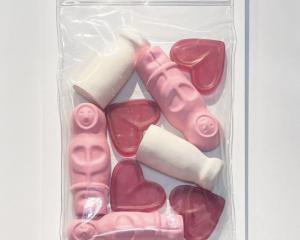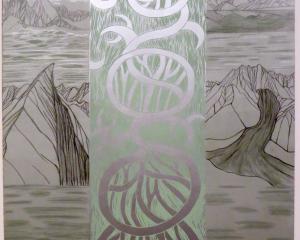Luke Hollis' images are impressive for the thorough and meticulous working of the canvas area. The entire mood of a scene is captured in the depth of background, often imparted through a delicate scumbling. This deceptive, careful, yet seemingly offhand backdrop allows the figures to appear in sharp focus despite their often pastel tones, as is the case in work such as the charming Flower basket. Several Southeast Asian portrait studies are also of note, including the finely composed Vietnamese girl with her perfectly captured expression.
Stephen Martyn-Welch's works are more varied in form and style. Several are assertive, in-your-face works with edgy subject matter and an almost photo-realistic style. Just as you begin to grasp this style, however, the artist throws you for a loop with delicately sensuous works like Landscape (the landscape in question being a reposing nude) and the impressive graphite work Bat girl. More surprising still is the classically informed Profile study, which provides a strong indication of where many of the artist's influences lie.
The works, with titles drawn from place names around Tokyo and Saitama in southeast Japan, are all quiet and contemplative, drawing their power from their ambiguous subjects. Influenced by the traditional masks of formal Japanese theatre, the images present forms which, though guided and formed on facial features, seem more sculptural than mask-like.
By focusing on these objects, we by analogy are assessing a culture by way of the mask which it deigns to show, the overlay of centuries of custom and tradition which, with limited knowledge, seems an impenetrable barrier. We are left with merely an impression of an abstraction of a culture rather than a clear view, in much the way that - were roles reversed - a Japanese tourist visiting New Zealand would have little ability to judge the meaning of a specific moko without explanation.
The images themselves are attractive, the impassive blossom and card masks precisely defined and floating free in front of dark backgrounds, or hinting at rather than fully showing the faces which lie behind them.
"Floating images", Charles Barrington, and "The corner dairy I", Paul Cardno (Gallery on Blueskin)
Barrington's predominant art is his photography, presented as a series of mostly small works on canvas. These images tend to focus on fine detail, notably on the interaction of nature with the built world. Weathered timber boards, the play of light on stonework, or the ballet-like grace of a single rose bloom all make fitting subjects for these visual haiku.
It is two larger works, however, that are most eye-catching and deserve attention. These pieces, in oil paint on board, excellently capture the translucence of coastal lighting in works so full of sheen and vibrancy I initially thought they might have been painted over metal.
Barrington's works surround The corner dairy I, a wondrous kinetic contraption by Paul Cardno which was on display recently in the Wall Street complex. A Heath Robinson/Rube Goldbergesque series of loops and tracks, the passage of pool balls through this mechanical marvel is simultaneously bewildering and hypnotic.
- James Dignan







![Untitled (c. mid 1990s, [pink 3]), by Martin Thompson, 415mm×590mm. Photo: courtesy of Brett...](https://www.odt.co.nz/sites/default/files/styles/odt_landscape_small_related_stories/public/story/2024/02/untitled_pink_3.jpg?itok=Q0aQrc9o)




